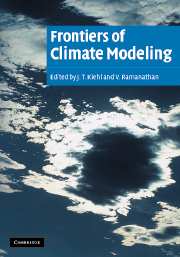
-
Select format
-
- Publisher:
- Cambridge University Press
- Publication date:
- August 2009
- August 2006
- ISBN:
- 9780511535857
- 9780521791328
- 9780521298681
- Dimensions:
- (247 x 174 mm)
- Weight & Pages:
- 0.942kg, 381 Pages
- Dimensions:
- (244 x 170 mm)
- Weight & Pages:
- 0.6kg, 378 Pages
You may already have access via personal or institutional login
Book description
The physics and dynamics of the atmosphere and atmosphere-ocean interactions provide the foundation of modern climate models, upon which our understanding of the chemistry and biology of ocean and land surface processes are built. Originally published in 2006, Frontiers of Climate Modeling captures developments in modeling the atmosphere, and their implications for our understanding of climate change, whether due to natural or anthropogenic causes. Emphasis is on elucidating how greenhouse gases and aerosols are altering the radiative forcing of the climate system and the sensitivity of the system to such perturbations. An expert team of authors address key aspects of the atmospheric greenhouse effect, clouds, aerosols, atmospheric radiative transfer, deep convection dynamics, large scale ocean dynamics, stratosphere-troposphere interactions, and coupled ocean-atmosphere model development. The book is an important reference for researchers and advanced students interested in the forces driving the climate system and how they are modeled by climate scientists.
Contents
Metrics
Altmetric attention score
Full text views
Full text views help Loading metrics...
Loading metrics...
* Views captured on Cambridge Core between #date#. This data will be updated every 24 hours.
Usage data cannot currently be displayed.
Accessibility standard: Unknown
Why this information is here
This section outlines the accessibility features of this content - including support for screen readers, full keyboard navigation and high-contrast display options. This may not be relevant for you.
Accessibility Information
Accessibility compliance for the PDF of this book is currently unknown and may be updated in the future.


